MARKET OVERVIEW
Essentially, the global multi-pack carriers market is an integral part of the packaging industry, which plays a critical role in facilitating the convenience of carrying or storing more than one product in a single unit. This will, therefore, turn out to be vital for the manufacturers and retailers who are trying to improve efficiency in their activities aimed at delivering their respective products to clients at the best possible price. This market is going to see a lot of changes in the future as companies try to innovate in order to fulfill the demands made by consumers and regulators who remain focused on sustainability and the environment.
The materials in this very market include plastic, paperboard, and metal, all carrying their benefits as well as challenges. Plastic, despite being the most used material presently due to its strength and low cost, has been under constant watch recently due to environmental concerns. The future of the global multi-pack carriers market is predisposed to accelerate in the use of more sustainable materials in light of companies moving to satisfy consumers' demands for more eco-friendly packaging. On the rise will be paperboard carriers, as they are biodegradable and recyclable, and businesses look to help reduce their carbon footprint. Although less used, metal carriers have the feature of being strong and reusable; hence, they find specific uses in an industrial setting.
Beginning with the food and beverage industry, followed by pharmaceuticals and consumer goods, they span a lot of industries—independent of which, requirements at every level will drive the design and material used in multi-pack carriers. For example, in the food and beverage industries, these carriers not only should be able to give strength and stability to their respective products but also ensure their safety and hygiene. Improvements in barrier coatings and antimicrobial treatments will dominate as companies race to meet extremely high health standards. Tamper-evident and child-resistant carriers, as required by the pharmaceutical industry, shall be guaranteed to prevent any harm and to protect medicinal products.
The future of the Global Multi Pack Carriers market will be influenced by technological advancements. The manufacturing process will be automated and digitalized, which will increase production efficiency while decreasing its cost. Smart packaging technologies that include QR codes and RFID tags will become prominent, enabling effective tracing and monitoring of products along the supply chain. All these developments not only increase operational efficiency but also provide insights regarding consumer behavior and preferences and thereby help companies design effective product-positioning campaigns.
It will greatly be influenced by the direction of the regulatory landscape. Governments and regulatory bodies around the world are mandating stricter regulations on packaging waste and the encouragement of recyclable and biodegradable materials. Companies operating in the Global Multi Pack Carriers market will have to see a change in their strategy with rising investments in research and development to come up with sustainable packaging solutions. This change will also foster innovation and collaboration among supply chain players in the need to jointly work on packaging sensitive to the environment, without altering its functionality or cost-effectiveness.
Consumer preference will also be one of the factors that will bend the trajectory of the market in the future. Consumer mentality is now factoring in green issues; therefore, it has become very selective about the kind of packagings used in the products it consumes. Companies will be propelled to change by providing packaging solutions in consumer values for areas such as reducing wastages and utilizing renewable resources. Marketing strategies will emphasize sustainability credentials in multi-pack carriers to allure green-minded consumers.
A shift towards innovation and sustainability as a source of differentiation is how the competitive landscape of the Global Multi Pack Carriers market would progress. Strategic partnerships and mergers and acquisitions may become more common in an effort by companies to increase their capabilities and more deeply penetrate the market. This will open up the pathway for new entrants and smaller players who can offer distinctive and sustainable solutions.
The Global Multi Pack Carriers market will undergo tremendous evolution in the next couple of years as the industry adapts to shifting consumer preferences, changing regulatory environments, and technological innovation. Innovation and responsiveness to calls for sustainable and efficient packaging are keys to a bright future for this industry. As companies invest in research and development, adopt new technologies, and engage with all the stakeholders, the market will surge higher and higher, going on to meet the requirements of various industries while contributing towards a more sustainable future.
Global Multi Pack Carriers market is estimated to reach $3,809.3 Million by 2031; growing at a CAGR of 4.54% from 2024 to 2031.
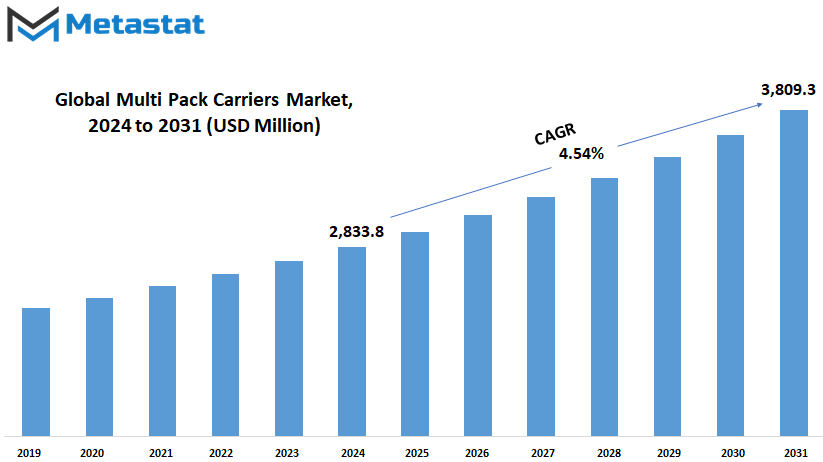
GROWTH FACTORS
The multi-pack carriers market worldwide is expected to exhibit great growth during the coming years, thanks to some catalyzing factors. One of the major driving factors is the growing trend of bulk purchasing among consumers. As consumers seek to buy more and visit the store less while saving money, the demand for multi-pack carriers is bound to rise. One sector where this trend is most specific is grocery and retail, whereby multi-pack carriers offer convenience and value to consumers.
Another critical driver for growth in the market is the heightened demand for functional and environmentally friendly packaging solutions. Consumers and business enterprises are fast becoming sensitive to the environment, hence opting for functional and green packaging. Another important trend in this direction is eco-friendly packaging, which is actually a response to the growing concern for plastic wastage and its toll on the environment. Therefore, firms are increasing their investment in recyclable, biodegradable, and renewable resource-based packaging solutions.
Some of the trends also act as restraints to market growth. The most important ones are the high costs of the raw materials used to make sustainable packaging. The price for the biodegradable and recyclable materials is usually higher than the conventional plastics; this may contribute to reasons why some businesses get discouraged from using such alternatives. Tight regulations on plastic use and heightened awareness of environmental issues create further impediments. This is intended to reduce plastic wastes and promote friendly materials, but it adds more complications and price factors to the packaging process.
The market will, however, continue to benefit from innovations in biodegradable and recyclable carrier materials. Material and process technologies are being developed that now make environmentally friendly packaging more cost-effective and efficient. This will likely create lucrative opportunities for companies in the multi-pack carriers market to respond to consumer demand for sustainable solutions in the face of regulatory pressures.
The global multi-pack carriers market grows in line with consumer demand for bulk purchasing and eco-friendly packaging solutions, even as high material costs and regulatory constraints look to counter this. Next-generation biodegradable and recyclable materials will further open up opportunities in this space. While these trends continue to evolve in their own right, the market shall adapt to offer innovative and sustainable solutions to meet changing consumer and business needs.
MARKET SEGMENTATION
By Type
The multi pack carriers of the Global market are anticipated to notice exceptional growth in upcoming years because of several driving factors. The primary is increasing consumer preference for bulk purchasing by people who want to buy in large quantities due to a minimum store-visits drive to save money. The demand for multipack carriers is supposed to go up. This is largely demonstrable within the grocery and retail sectors, whereby multi-pack carriers provide various consumer amenities in addition to value.
The growth of the market is primarily drawn from the two main factors: convenience and environmental-friendliness. Packaging that is becoming functional and environmentally friendly is both a consumer and a business preference. The adoption of such packaging is not a trend but a response to the concern over the upsurge of plastic waste in the environment. In light of this, companies have thus been making increased investments in packaging solutions that are either recyclable, biodegradable, or derived from renewable resources.
Though there are diversified positive developments in the market, it has to face some challenges. One of the main constraints comes in the high cost of the raw materials needed for sustainable packaging solutions. Some of these alternatives carry a higher cost than conventional plastics, which discourages their adoption by some businesses. Other difficulties include rigid guidelines on using plastics and even more concern for the environment. These pose a real challenge to the packaging process, just like the above-mentioned regulations have in the goal of reduced plastic waste and the use of more sustainable materials.
However, the market is poised to benefit from innovations in biodegradable and recyclable carrier materials. Every technological development in this field holds out the promise of new materials and new manufacturing processes that make eco-friendly packaging less costly and more effective. In fact, these innovations are most likely to present beneficial opportunities for companies in the multi-pack carriers market to meet the unmet demand by consumers for more sustainable solutions and the regulatory pressures in the market.
In general, the global multi-pack carriers market is driven by growing consumer consciousness towards making bulk purchases along with an increasing demand for ecologically feasible packaging solutions. The growth rate in this market is, however, expected to be dragged down by material costs and regulatory impositions. MYRIAD-2 shall thus make room for the needed opportunities in market expansion. In the course of these new trends, the market shall be very agile in offering innovative and sustainable solutions to new needs emanating from consumers and businesses alike.
By Material-Type
The Global Multi Pack Carriers market is growing toward a height with the Rey of various material types attending to different packaging needs. As industries evolve in the future years, so will be the demand for diversified packaging solutions that shall dictate the future of multi-pack carriers. The segmentation of the market by material type includes Paper & Paperboard, Coated Unbleached Kraft Paperboard, Bleached Kraft Paperboard, Plastic, Polyethylene, Polypropylene, and Polyethylene Terephthalate, among others.
Paper & Paperboard continues to be one of the most utilized categories because it is recyclable and a sustainable resource. With the increased concerns for the environment, companies will tend to use more Coated Unbleached Kraft Paperboard and Bleached Kraft Paperboard since they are more resistant while reducing their impact on the environment. It is simply preferred because of its easy recyclability and lower carbon footprint compared to alternative traditional packaging solutions.
Other important plastic materials include polyethylene, polypropylene, and polyethylene terephthalate. Such plastics are vastly utilized in many areas because they possess the properties of strength, flexibility, and resistance to moisture, which enable them to be utilized in many products. Polyethylene is very versatile and relatively inexpensive, whereas polypropylene is clearer and more chemically resistant. High strength and the preservation of freshness are some of the traits that have popularized polyethylene terephthalate, making it one of the most favored materials in many applications.
In the future, there will be a greater need for more sustainable and innovative materials. Demand for eco-friendly options will therefore lead to the development of advanced materials that meet not just functional needs but are sensitive towards the environment. Firms will concentrate on incorporating new technologies and materials to comply with regulatory standards and consumer preferences by way of greener products.
In view of this, the Global Multi Pack Carriers market will continue to increase due to businesses’ need for packaging solutions that are functional and environmentally friendly. As the world increases its focus on sustainability, much attention is likely to be on materials that mean less waste and more consideration is being given to recycling. Packaging technology shall advance and help to further expand the market by having multi-pack carriers evolve with dynamic changes in industry needs and expectations around the environmental conditions.
Most simply put, the future for the Global Multi Pack Carriers market is to be defined by innovations in material types and an ever-increasing dose of sustainability and innovation. Paper & Paperboard, alongside multiple plastic materials, already dominate the landscape and are expected to retain the top position, while new developments shall comply not only with functionality needs but also with environmental requirements on packaging solutions that befit a changing world.
By Application
The Global Multi Pack Carriers market will undergo tremendous changes in the coming years. This research report examines some of the major factors that will impact its prospects. Increasing demand for convenience and sustainability will remain the principal drivers of the market in different applications.
Multi pack carriers will become very imperative in the beverage industry. The same can be said for carriers for alcoholic, as well as non-alcoholic beverages. In terms of alcoholic beverages, this could mean a change in consumer preference for beer, wine, and other spirits, thus calling for a reformation in multi-pack carriers by developing packaging solutions that are more user-friendly, convenient, and offer some additional functionality. With more and more usage of these drinks, the demand for rugged, green carriers will increase, thus driving innovation through material and design.
The growth in the non-alcoholic beverage category is also going to continue boosting the market. Rising health consciousness and a growing consumption of juices, milk products, and carbonated drinks are sure to guarantee that multi pack carriers will be designed to meet the requirements of a host of beverages. This will then translate to carriers supporting different packaging needs, ensuring their handling of various sizes and types of products maintains product integrity. Material and design innovations will aim to offer improved protection, ease of transport, and sustainability.
Looking ahead, the global multi-pack carriers market will progressively make a shift to new packaging technologies. The manufacturer will not only stress on developing a functional solution but also an eco-friendly one. More prominent use of recyclable and biodegradable materials will be in place, considering the global movement against plastic waste. Easy design will also be an aspect of changing consumer preference, with increasing importance given to aesthetics and functionality.
The market is constantly evolving; hence, companies have to be able to move and respond to these changes in consumer needs. This will result in corporations investing in research and development for the creation of packaging solutions that answer not only current needs but also future ones. Smart technologies that are embedded in packaging, like QR codes or item-tracking systems, enrich the experience for the consumer and provide manufacturers with invaluable data.
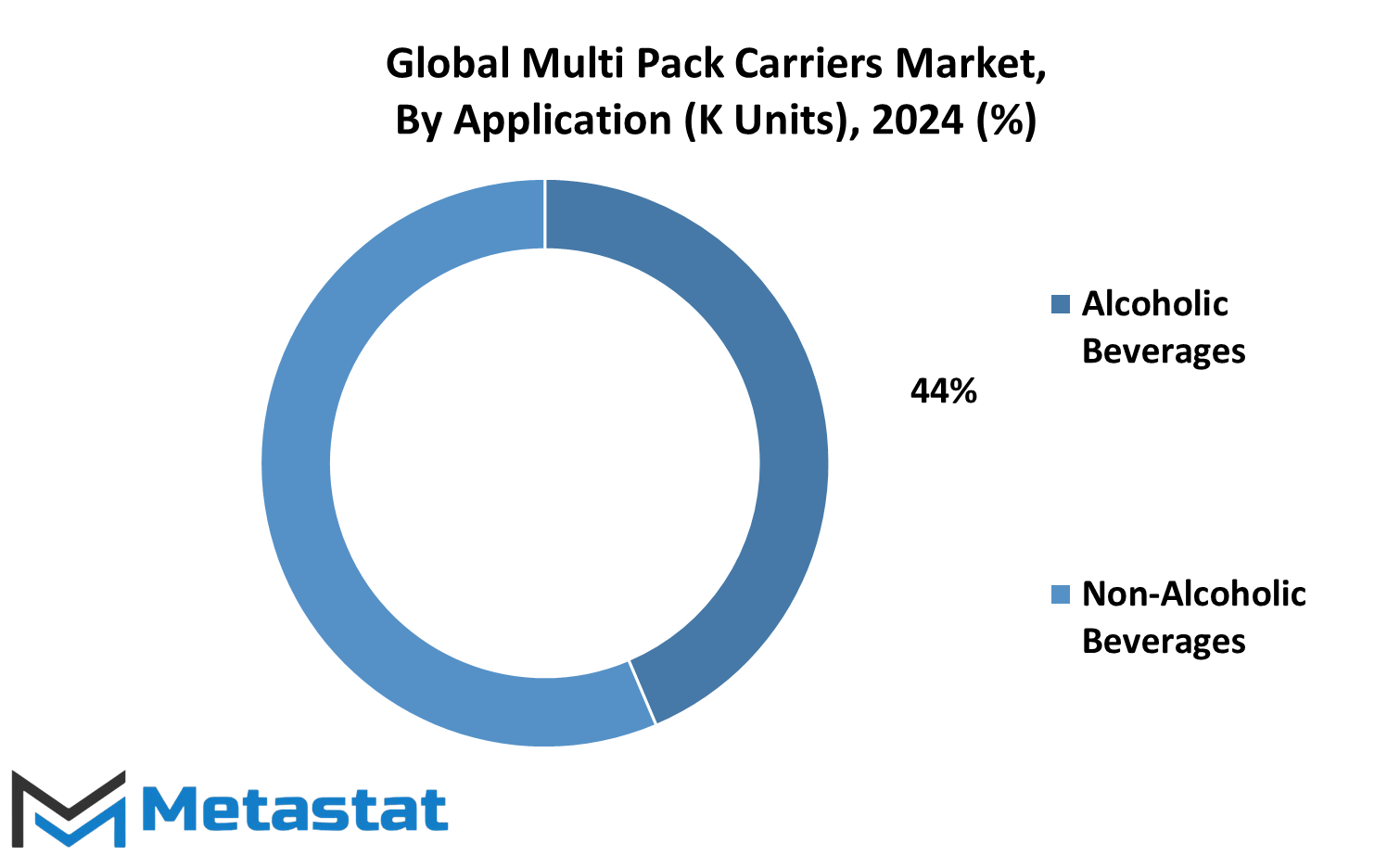
REGIONAL ANALYSIS
The global market for Multi Pack Carriers promises to experience major development featuring a diversified and dynamic landscape across regions. Multi-packaging carrier market geographical segmentations: North America, Europe, Asia-Pacific, South America, Middle East, and Africa show individualistic characteristics and growth potentials.
Marketwise, it can be divided into the following main regions: the U.S., Canada, and Mexico. The U.S. backs up for its matured end-user segments, large consumer base, and strong packaging industry. Canada also remains very active in this market, doing a lot of work on sustainability and innovation. Increasing economy uptrends in Mexico are boosting demand for multi-pack carriers.
Another critical region encompasses Europe— the UK, Germany, France, Italy, and rest of Europe. UK and Germany play important roles because these countries have very aggressive manufacturing industries and are strictly looking for sustainable, environmental-friendly solutions in packaging. France and Italy are known for the novelty in packaging that caters to a wide variety of consumer requirements. Rest of Europe consists of many poor countries where the trend of these new packaging technologies is just kicking in.
Geographically, Multi-Pack Carrier Market is divided into India, China, Japan, South Korea, and the Rest of Asia-Pacific. In addition, China and India are fast-growing markets with the highest population and developing economy. China's more modern focus and other developing economies like that of India are making significant contributions to the demand for multi-pack carriers. Japan and South Korea are noted to have better technology levels and standards in packaging that to a certain level influences new market trends in the market within the region. Other developing markets in the region will be identified in The Rest of Asia-Pacific as they are beginning to show potential to embrace new packaging solutions.
Consisting of Brazil, Argentina, and the rest of South America, the Brazilian demand, in particular, is driven by its huge economy and is being propelled by the recent growth of the retail sector and the growing importance of sustainable packaging. Argentine and other countries in the region are slowly starting to use more multi-pack carriers as more infrastructure and consumer markets are built.
The Middle East & Africa further segments into the GCC Countries, Egypt, South Africa, and the Rest of Middle East & Africa. The GCC Countries are high in major shares due to the fast-growth rate in their economies and infrastructural developments. Most of the growth in Egypt and South Africa is driven by their large consumer bases and rising industrial activities. The Rest of the Middle East & Africa countries remain full of potential and will grow with the improvements made in the economic development.
In essence, the global Multi Pack Carriers market will continue to progress with each region offering vastly different opportunities and challenges. With consumer demand for sustainable and innovative products at an all-time high, this market will experience much growth in new packaging technologies and adopt multi-pack carriers across geographies.
|
Report Coverage |
Details |
|
Forecast Period |
2024-2031 |
|
Market Size in 2024 |
$2,833.8 million |
|
Market Size by 2031 |
$3,809.3 Million |
|
Growth Rate from 2024 to 2031 |
4.54% |
|
Base Year |
2022 |
|
Regions Covered |
North America, Europe, Asia-Pacific Green, South America, Middle East & Africa |
COMPETITIVE PLAYERS
The Global Multi Pack Carriers market is going to bring tremendous changes in the upcoming years, as companies are struggling and trying to deliver innovation, matching the changing needs of consumers and industries likewise. It involves major players in this market with well-established firms like Smurfit Kappa Group plc, WestRock Company, and Graphic Packaging International, LLC. These companies have been ahead of the game at advancements in multi-pack carrier technologies, pushing functionality and sustainability frontier boundaries farther.
Among the companies, the one that stands out with the most extensive portfolio and broadest global reach is Smurfit Kappa Group plc, which offers versatile and eco-friendly solutions for packaging. An endless list of research and development from their side testifies to the fact that they continue to be in step with the needs of a growing and increasingly large and heterogeneous target market. On the other hand, WestRock Company has placed itself at the forefront by marrying state-of-the-art technology with sustainable practices that are the foundation set well for growth in the future.
Another major player, Graphic Packaging International, LLC, is also working on improving the efficiency and environmental footprint of its products. Their latest innovations in multi-pack carriers only go to show how the company has been tuned in to the larger industry trends of sustainability and minimal waste. This focus on eco-friendliness will possibly assume a more significant role in times to come, since environmental regulations are likely to go strict and consumers shift more toward green.
Other important vendors operating in this market are Fishbone Packaging Inc and British Polythene Limited. For instance, while Fishbone Packaging Inc. has a specialization in customized products, many of which fill special packing needs, British Polythene Limited offers multi-pack carriers that strike a balance between durability and sensitivity toward the environment. These both firms are likely to continue their efforts in innovating solutions in tune with the changing requirements of the customers.
Other substantial players include Grip-Pak, Wynalda Packaging, and Canada Kegs & Packaging, each of whom has a special strength to offer around this market. For instance, Grip-Pak provides flexibility with packaging, whereas Wynalda Packaging and Canada Kegs & Packaging supply multi-pack carriers to increase safety and efficiency throughout the product's production.
Roberts PolyPro, Berry Global Group, and Crown Holdings are equally important stakeholders within the industry. Innovation in packaging solutions from Roberts PolyPro and the strong product portfolio of Berry Global Group place further emphasis on multi-pack carrier technologies. Crown Holdings, with vast renowned experience in packaging solutions, is considered destined to continue shaping market trends and driving further growth.
These players, together with DS Smith, Huhtamaki, International Paper, and Klabin S.A., which are set to develop the market, focus on sustainable packaging solutions and innovation. What International Paper and Klabin S.A. bring to the table are many years of experience and substantial resources behind them to further develop technologies for multi-pack carriers.
As the industry grows, these players will, therefore, be greatly important in the way that they help shape the future of the global multi-pack carriers market. Innovation and sustainability efforts that they continue to offer will drive the industry to new heights, catering to ever-more-complex and ecologically conscious markets.
Multi Pack Carriers Market Key Segments:
By Type
- Baskets
- Trays
- Other
By Material-Type
- Paper & Paperboard
- Coated Unbleached Kraft Paperboard
- Bleached Kraft Paperboard
- Plastic
- Polyethylene (PE)
- Polypropylene (PP)
- Polyethylene Terephthalate (PET)
- Others
By Application
- Alcoholic Beverages (Beer, Wine, Others)
- Non-Alcoholic Beverages (Juices, Milk Products, Carbonated Drinks, Others)
Key Global Multi Pack Carriers Industry Players
- Smurfit Kappa Group plc
- WestRock Company
- Graphic Packaging International, LLC
- Fishbone Packaging Inc.
- British Polythene Limited
- Grip-Pak
- Wynalda Packaging
- Canada Kegs & Packaging
- Roberts PolyPro
- Berry Global Group
- Crown Holdings
- DS Smith
- Graphic Packaging International
- Huhtamaki
- International Paper
WHAT REPORT PROVIDES
- Full in-depth analysis of the parent Industry
- Important changes in market and its dynamics
- Segmentation details of the market
- Former, on-going, and projected market analysis in terms of volume and value
- Assessment of niche industry developments
- Market share analysis
- Key strategies of major players
- Emerging segments and regional growth potential



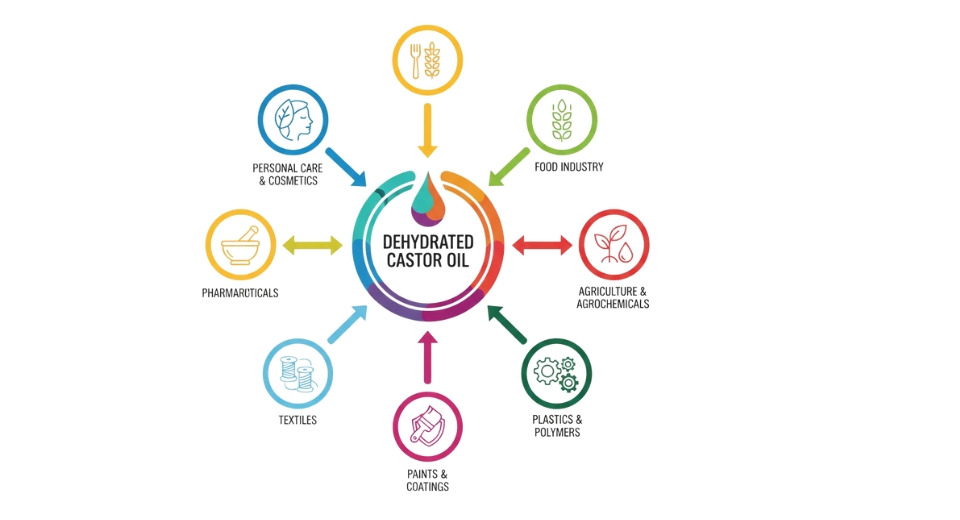
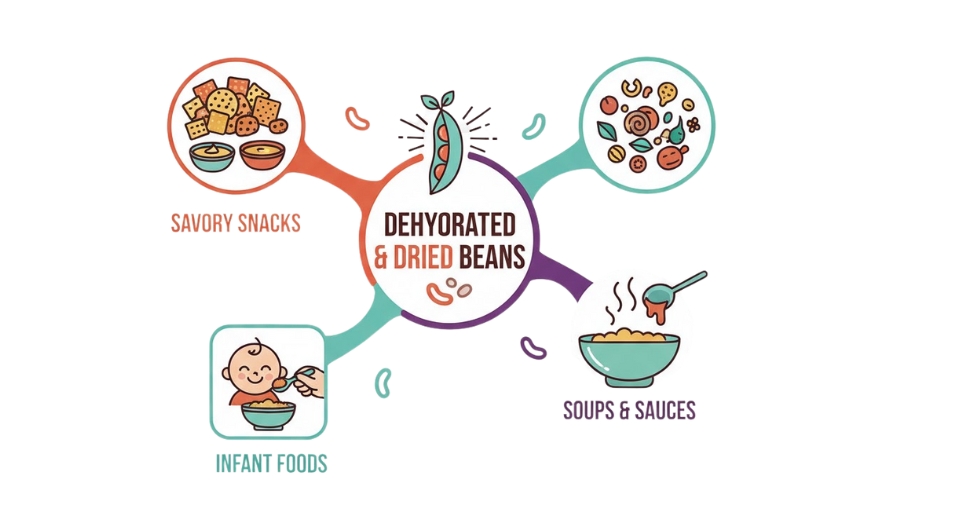
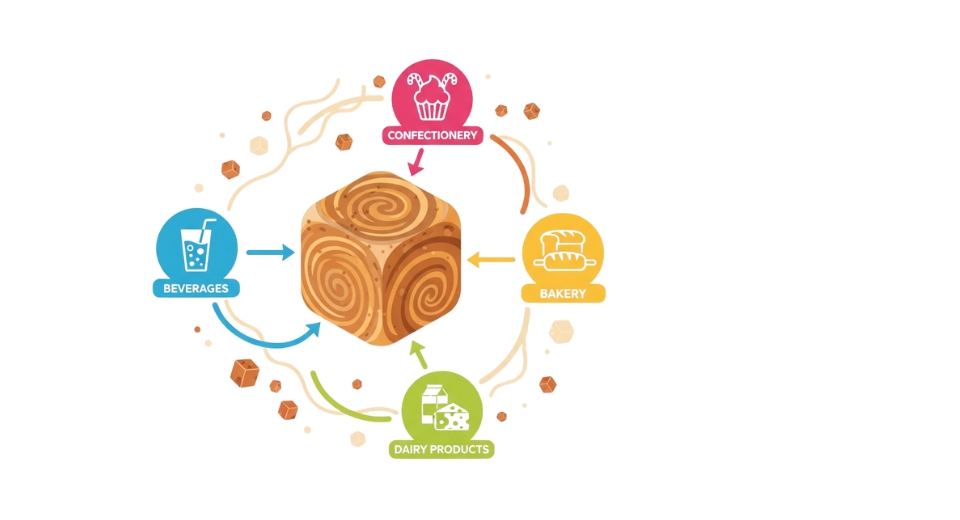
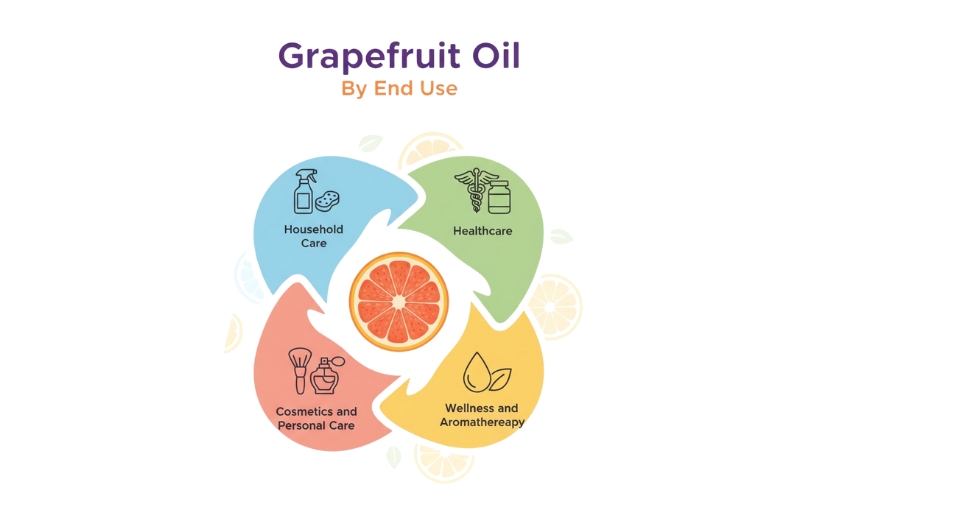

 US: +1 3023308252
US: +1 3023308252






